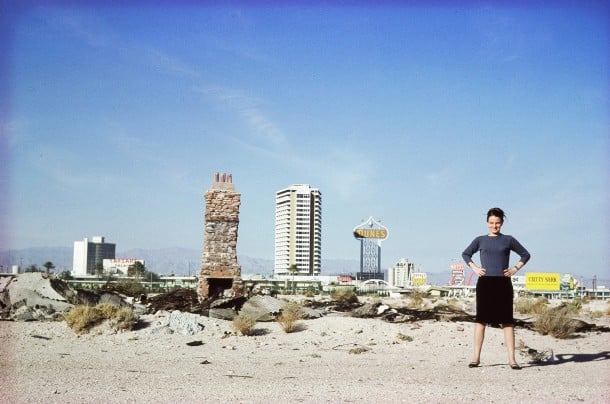A new petition demanding that the Pritzker Prize Committee recognise the contribution of Denise Scott Brown is rapidly collecting signatures – add yours.
The Women in Design group at Havard’s GSD has started a petition asking the Pritzker Prize Committee to recognise Denise Scott Brown alongside Robert Venturi in the 1991 Pritzker Prize. The petition follows on from Scott Brown’s keynote at the AJ Women in Architecture Awards, which received substantial coverage. Uptake has been swift with 947 signatures at the time of writing.
The petitioners write:
Women in architecture deserve the same recognition as their male counterparts. Denise Scott Brown’s contributions were seminal to her partner Robert Venturi winning the prize in 1991. It was an unfortunate oversight by the Pritzker Architecture Prize committee to deny her of the recognition she undoubtedly had earned.
We demand that Denise Scott Brown be retroactively acknowledged for her work deserving of a joint Pritzker Prize.
Brown had been a co-partner for over 22 years in their practice Venturi Scott Brown and Associates and played a critical role in the evolution of architectural theory and design alongside Venturi for over 30 years. She co-authored the 1977 book Learning from Las Vegas, among others.
However, her role as “wife” seemed to have trumped her role as an equal partner when the Pritzker jury chose to only honor her husband, Venturi.
“Let’s salute the notion of joint creativity.” – Denise Scott Brown
For women’s equality to become a reality today, we need to rectify the mistakes of the past. Help change history by demanding equal recognition for equal work.
I encourage everyone to sign.
Scanning the comments on the petition and the online conversation around it is also instructive. Most of the comment I have seen has been supportive, with many suggesting it is a no-brainer, OF COURSE she should be recognised. Although I haven’t looked at it all in detail, a few seem worth repeating.
One of the more poignant comments accompanying the petition is from Jeremy Till, who writes:
I was at a conference in Washington the day the Pritzker for Venturi was announced. Denise Scott Brown was the keynote. Her answers to the questions at the end about the award were so dignified, furious and loving (all at the same time) that she should be awarded the Pritzker in her own right just for that.
One of the more surprising was made in a tweet from Robert Ivy, CEO of American Institute of Architects, and former longtime editor of the American journal Architectural Record, who responded to John Cary’s request for AIA’s support thus: “2013 is another century, another chance. Would we make the same decisions today? I doubt it.” Cary pointed out that it was only last year that Wang Shu was awarded the prize, but not his partner Lu Wenyu. (More on that by Christopher Hawthorne here.)
It also alarmed me to see 1991 being framed as a time when we knew no better. Yes, 1991 seems a long time ago, but my recollection is of feminism being a key part of architectural theory at that time. Things went quiet later, but in 1991 gender was an important aspect of architecture in my neck of the woods. (Admittedly this was the University of Auckland School of Architecture, but we were reading a lot of stuff coming from the US and elsewhere, in addition to the excellent teaching of people such as Sarah Treadwell). So, it’s not so easy to dismiss the neglect of Scott Brown as something from the ancient, unknowing past. More complex, systemic issues are at work.
As Scott Brown herself commented in Architectural Record when Zaha Hadid was awarded the Pritzker in 2004:
The Pritzker jury has a certain definition of architecture, an almost 19th century notion of great men and of design that is generated through the genius of one mind. It’s taken a long time to find a woman to fit these notions.1
Hilde Heynen comprehensively outlines the gendered construction of the ‘star’ architect through the Pritzker in her long essay “Genius, Gender and Architecture: The Star System as Exemplified in the Pritzker Prize“. This is in the recent special issue of Architectural Theory Review on “Women, Practice, Architecture” edited by Naomi Stead. (Behind a hefty paywall, so get to a subscribing university library.)
The second surprising comment came from a spokesperson from the Pritzker Prize itself, quoted in The Architect as saying this “was the first time that the committee had heard about Scott Brown’s remarks”. This seems remarkable given the frequency with which the issue has been raised by Scott Brown and others over the years.
Hopefully this time, with awareness of gender again in the architectural spotlight, the strong campaign being run by the Architects Journal among others and the weight of the petition will combine to pressure the Pritzker Prize Committee into rethinking this, as well as the broader issues that attend the prize and the way that it is awarded.
If you haven’t signed, please do.
- Ten Conversations about Zaha Hadid, Architectural Record 192, no. 5 (May 2004), 25.[↩]





















